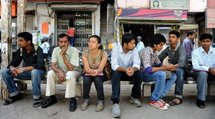Technology, tradition combine in Asian 'gendercide'
Ben Sheppard
NEW DELHI, Ben Sheppard- While having a scan, a pregnant woman in India is not allowed to learn the gender of her unborn child. But her bill might be presented in a file coloured blue or pink -- and the meaning is clear.
The method of skirting around the law is one of many reasons why 85 million women are described as "missing" from the populations of India and China, where the abortion of female foetuses, infanticide and the death of girls through neglect is all too common.

"Tricks like coloured folders are absolutely common," Pinki Virani, a leading women's rights campaigner in India, told AFP.
"So-called 'gendercide' is a daily reality across rich or poor, rural or urban. It doesn't matter if the family lives in a village, the smart suburbs, or have even emigrated to Canada."
The term "missing women" was coined by Nobel Prize-winning economist Amartya Sen in 1990.
The number is estimated by comparing the actual sex ratio in any population with what it would theoretically be if equal treatment were given to the sexes during pregnancy, birth and afterwards.
A report from the United Nations Development Programme last week said 100 million women were "missing" in Asia -- 85 million from China and India, but also from Bangladesh, Iran and Pakistan.
"If your clinic won't tell you the gender of your unborn child, now you can courier a blood sample to the US and get the results back by email," said Virani.
"I've seen for myself that a lack of girls can have disastrous knock-on effects in any community: more polyandry (females with multiple partners), more child sex abuse, and more prostitution."
Gender imbalances have worsened across much of Asia where the traditional preference for male births has combined with modern technology such as ultrasound scans that make it easy to know the gender of an unborn child.
Sex-selective abortion was banned in China in 1995 but, according to a study this year by the Chinese Academy of Social Sciences, more than 24 million men of marrying age could find themselves without spouses in 2020.
Medical experts say the natural gender ratio should be 103-107 males born for every 100 females -- a tilt that apparently compensates for higher infant mortality rates in males.
But in 2005, the last year of available data, there were 119 boys for every 100 girls in China, and in some areas the figure was 130 boys to 100 girls.
Under China's 1979 one-child policy, aimed at controlling the world's largest population, parents who live in cities are generally allowed one child, while some rural families can have two.
"The imbalance is more prominent in rural areas because education in villages is lower than in the cities," Yang Hongjuan, a demographics expert at the Shaanxi Academy of Social Sciences, told AFP.
The pressure to produce a male child has grim consequences that are detailed in a new book by Chinese writer Xinran Xue.
She tells of seeing a newborn girl discarded in a chamber pot, and of mothers who attempt suicide tormented by guilt after killing their daughters.
But for some women in China, the one-child policy is a boon, helping reduce population pressure and giving them more power.
"I support it as there are too many people in China," 42-year-old married professional Zhang Hua told AFP in Beijing.
"The gender imbalance is good for girls. It gives them more choice, and makes men behave better."
In India -- which has about 108 males to 100 females in children under six -- the preference for boys is partly due to the key role that sons play in Hindu funeral ceremonies.
Other factors are the substantial dowry gifts that a father must provide for his daughter's new family at her wedding, and the fact that sons are often seen as breadwinners and daughters as financial burdens.
"Murder of female newborns is actually declining," said Kavita Srivastava, an activist for the People's Union for Civil Liberties in India.
"Sex-selective abortions are instead the problem because portable ultrasound machines are taken around villages and towns. A scan can cost as little as 10 dollars, and a hospital abortion just 45 dollars."
She says the effects of China's one-child policy are the same as India's social revolution, which has seen modern families have just two children instead of several.
"After their first daughter, parents now desperately want a son, rather than having more and more children and hoping nature gives them a boy," she said.
---------------------------------------------------------------------------